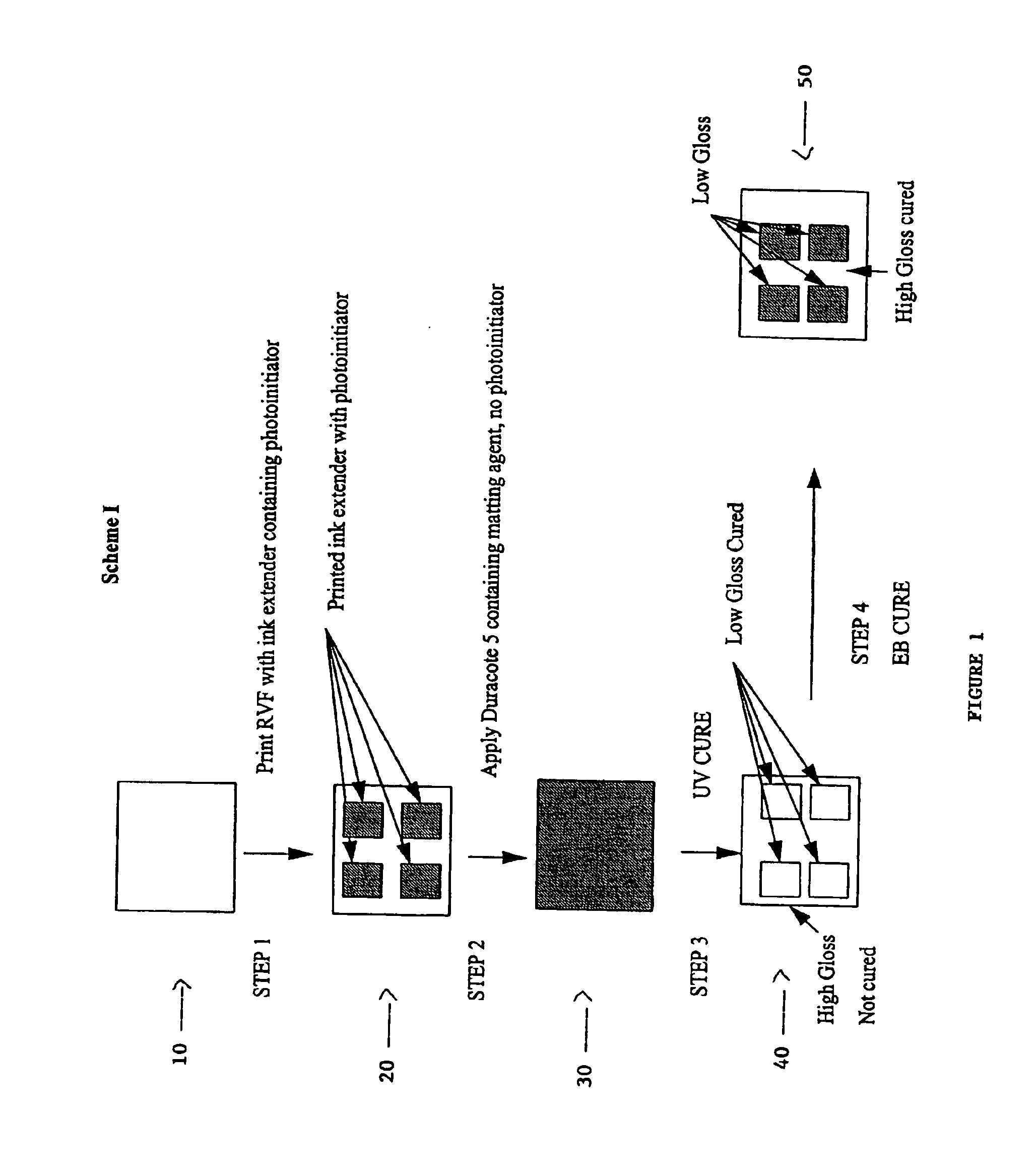Surface covering having gloss in-register and method of making
- Summary
- Abstract
- Description
- Claims
- Application Information
AI Technical Summary
Benefits of technology
Problems solved by technology
Method used
Image
Examples
example 1
Representative Coating Compositions
[0072]A hydroxy terminated polyester (Polyester 1) was prepared as described in Example 1 of U.S. Pat. No. 5,663,003 with the following charge weights:
[0073]
1,6 Hexanediol992.7 gGlycerin133.5 gPhthalic Anhydride 1071 gDibutyltin Dilaurate 0.5 g
[0074]The reaction mixture was cooled and total amount of water collected was 135 grams. The final product gave an acid number of 2.4 and a hydroxyl number of 179, providing a hydroxyl equivalent weight of 316.
[0075]A coating composition including Polyester 1 was prepared by mixing the following charge in a flask equipped with heating mantel, stirrer, and dry air purge at 0.3 SCFH.
[0076]
Tone M-100, Hydroxyacrylate from Union carbide697.2 gSartomer SR395 (Isodecyl acrylate)596.1 gSartomer SR238(1,6 hexanediol diacrylate)127.8 gPolyester 1406.8 g
[0077]This mixture was stirred briefly at 26° C. To the mixture was added:
[0078]
Desmodur W Bayer's isocyanurate dimer441.6 gT12 catalyst (Dibutyl tin dilaurate) 4.62 g
[...
example 2
Representative Coating Composition
[0081]A second coating composition was prepared as described in Example 1 of U.S. Pat. No. 5,663,003. The composition was prepared from the following charge in a 2 Liter flask equipped with heating mantel, stirrer, and dry air purge at 0.25 SCFH:
[0082]
Tone M-100, Hydroxyacrylate from Union carbide126 gMonomer mixture (27.5% by wt Sartomer SR499,125 g27.5% by wt Sartomer SR502, 45% by wt.Sartomer SR351)Polyester 1 35 g
This mixture was heated to 100° F. The following was added:
[0083]
Desmodur N-3300, Bayer's isocyanurate trimer87 g
[0084]This mixture was heated to 185° F. (85° C.) and maintained at this temperature for five hours. The mixture was cooled and to the flasks was added:
[0085]
Monomer mixture (27.5% by wt Sartomer SR499,15 g27.5% by wt Sartomer SR502, 45% by wt.Sartomer SR351)Surfactant Dow Coming 193 1 g
[0086]An infrared spectrum confirmed that all of the NCO groups had reacted
example 3
Representative Coating Composition
[0087]Acrylated Polyester 2
[0088]A hydroxy terminated polyester (polyester polyol) as described in Example 2 of U.S. Pat. No. 5,663,003 was prepared. The final product gave an acid number of 2.5 and a hydroxyl number of 207, providing a hydroxy equivalent weight of 274 and an estimated number average molecular weight of 880.
[0089]The polyester was acrylated as described in Example 7 of U.S. Pat. No. 5,663,003. The acid number of the product was 34. A coating composition including Polyester 2 was prepared from the following charge in a 12 liter flask:
[0090]
Trimellitic anhydride 2259 g1,6-Hexanediol 5291 gPhthalic Anhydride 1406 gp-Toluenesulfonic acid 1.8 g
[0091]The flask was equipped with a mantle, stirrer, thermometer, temperature controller, gas inlet tube, and an upright condenser. The condenser was steam heated and packed with glass helices and had a thermometer on top. The still led to a water-cooled condenser that drained into a graduated cyli...
PUM
| Property | Measurement | Unit |
|---|---|---|
| Concentration | aaaaa | aaaaa |
| Transparency | aaaaa | aaaaa |
| Level | aaaaa | aaaaa |
Abstract
Description
Claims
Application Information
 Login to View More
Login to View More - R&D
- Intellectual Property
- Life Sciences
- Materials
- Tech Scout
- Unparalleled Data Quality
- Higher Quality Content
- 60% Fewer Hallucinations
Browse by: Latest US Patents, China's latest patents, Technical Efficacy Thesaurus, Application Domain, Technology Topic, Popular Technical Reports.
© 2025 PatSnap. All rights reserved.Legal|Privacy policy|Modern Slavery Act Transparency Statement|Sitemap|About US| Contact US: help@patsnap.com

